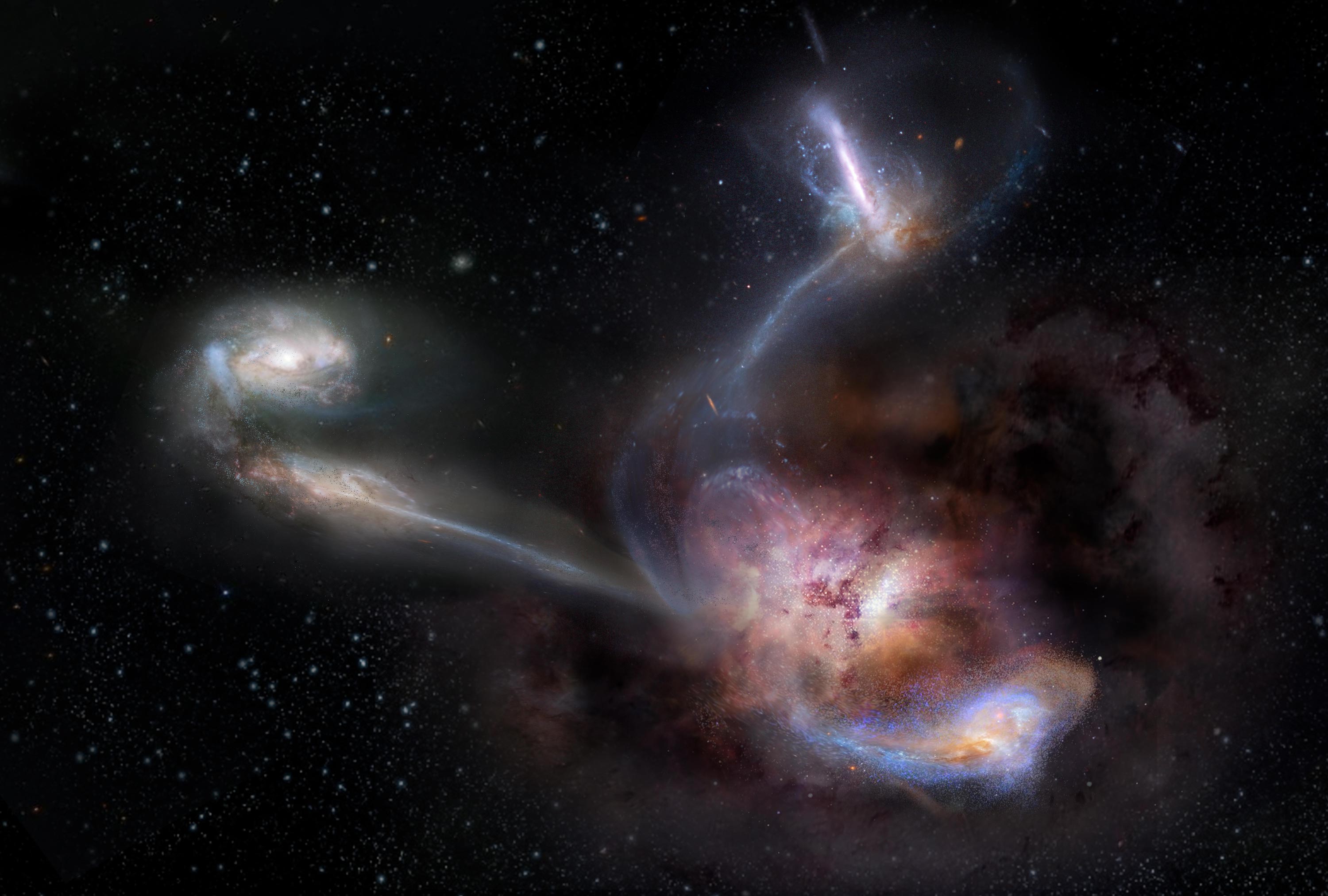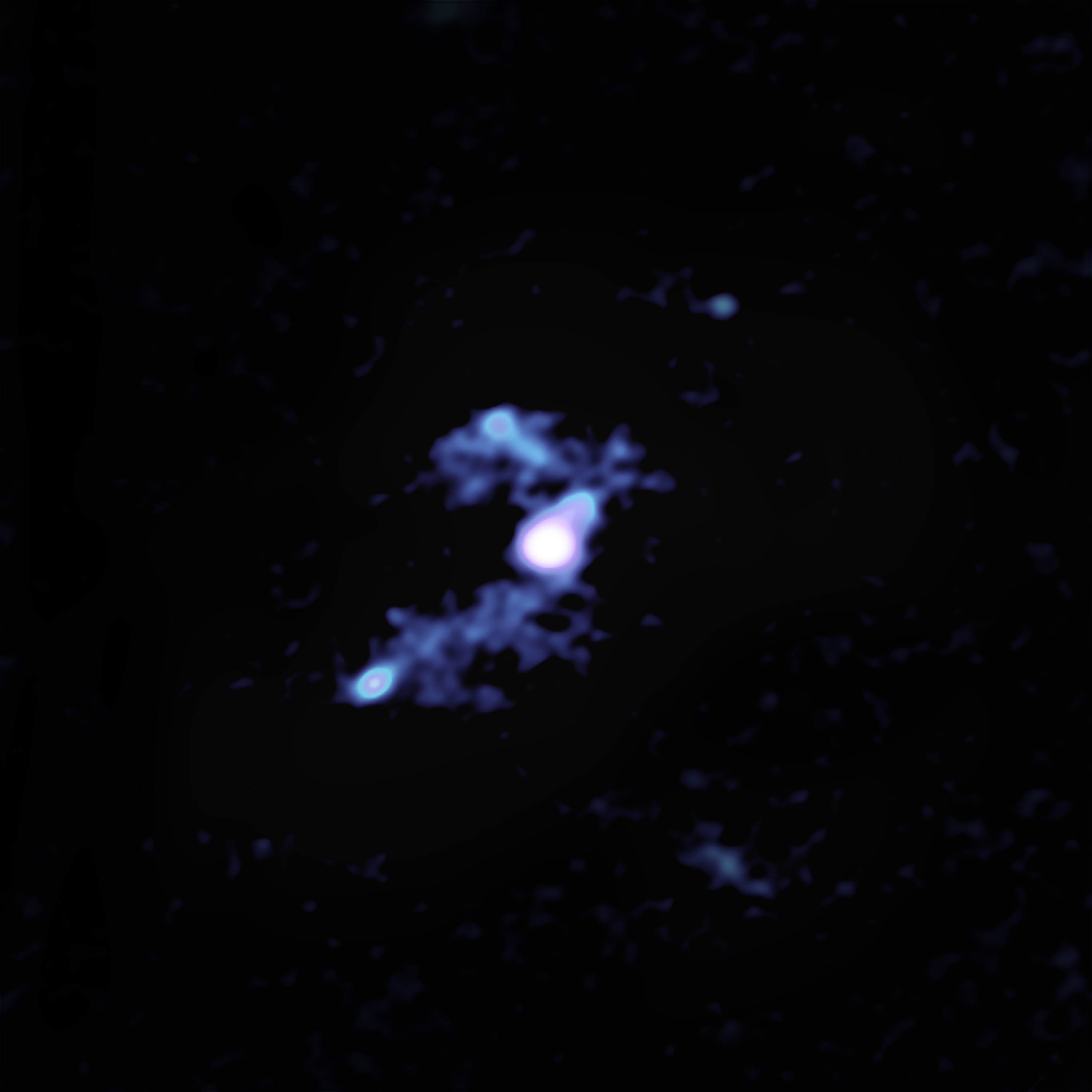NASA | JPL-Caltech | 2018 Nov 15
The most luminous galaxy ever discovered is cannibalizing not one, not two, but at least three of its smaller neighbors, according to a new study published today (Nov. 15) in the journal Science ... The material that the galaxy is stealing from its neighbors is likely contributing to its uber-brightness, the study shows.
- This artist's impression shows galaxy WISE J224607.55-052634.9, the most luminous galaxy ever discovered. A new study using data from the Atacama Large Millimeter/submillimeter Array (ALMA) shows that this galaxy is syphoning dust and other material from three of its smaller galactic neighbors. Credit: NRAO/AUI/NSF, S. Dagnello
Discovered by NASA's space-based Wide-field Infrared Survey Explorer (WISE) in 2015, the galaxy, called WISE J224607.55-052634.9, is by no means the largest or most massive galaxy we know of, but it radiates at 350 trillion times the luminosity of the Sun. If all galaxies were positioned an equal distance from us, WISE J224607.55-052634.9 (or W2246-0526 for short) would be the brightest.
New observations using the Atacama Large Millimeter/submillimeter Array (ALMA) in Chile reveal distinct trails of dust being pulled from three smaller galaxies into W2246-0526. The trails contain about as much material as the smaller galaxies themselves, and it's unclear whether those galaxies will escape their current fate or will be completely consumed by their luminous neighbor. ...
A companion study about W2246-0526, published on Nov. 14 in the Astrophysical Journal, provided the mass measurement for the supermassive black hole at the galaxy's center - 4 billion times the mass of the Sun. This mass is large, but the extreme luminosity of W2246-0526 was thought to require a supermassive black hole with a mass at least three times larger, according to the paper authors. Solving this apparent contradiction will require more observations. ...
Trans-Galactic Streamers Feeding Most Luminous Galaxy in the Universe
ALMA | NRAO | NAOJ | ESO | 2018 Nov 15
The most luminous galaxy in the universe has been caught in the act of stripping away nearly half the mass from at least three of its smaller neighbors, according to a new study published in the journal Science. The light from this galaxy, known as W2246-0526, took 12.4 billion years to reach us, so we are seeing it as it was when our universe was only about a tenth of its present age.
- ALMA image reveals how W2246-0526 is being fed by three companion galaxies through trans-galactic streamers of gas. The main galaxy and one of its companions are in the center. To the lower left is another companion and its large tidal tail that connects it to the main galaxy. The upper left concentration is the third such companion galaxy. Credit: ALMA (ESO/NAOJ/NRAO),T. Díaz-Santos et al.; S. Dagnello (NRAO/AUI/NSF)
New observations with the Atacama Large Millimeter/submillimeter Array (ALMA) reveal distinct streamers of material being pulled from three smaller galaxies and flowing into the more massive galaxy, which was discovered in 2015 by NASA’s space-based Wide-field Infrared Survey Explorer (WISE). It is by no means the largest or most massive galaxy we know of, but it is unrivaled in its brightness, emitting as much infrared light as 350 trillion Suns.
The connecting tendrils between the galaxies contain about as much material as the galaxies themselves. ALMA’s amazing resolution and sensitivity allowed the researchers to detect these remarkably faint and distant trans-galactic streamers. ...
The Multiple Merger Assembly of a Hyperluminous Obscured Quasar at Redshift 4.6 ~ T. Díaz-Santos et al
- Science (online 15 Nov 2018) DOI: 10.1126/science.aap7605
- Astrophysical Journal 868(1):15 (2018 Nov 20) DOI: 10.3847/1538-4357/aae698
viewtopic.php?t=35558
viewtopic.php?t=34800

